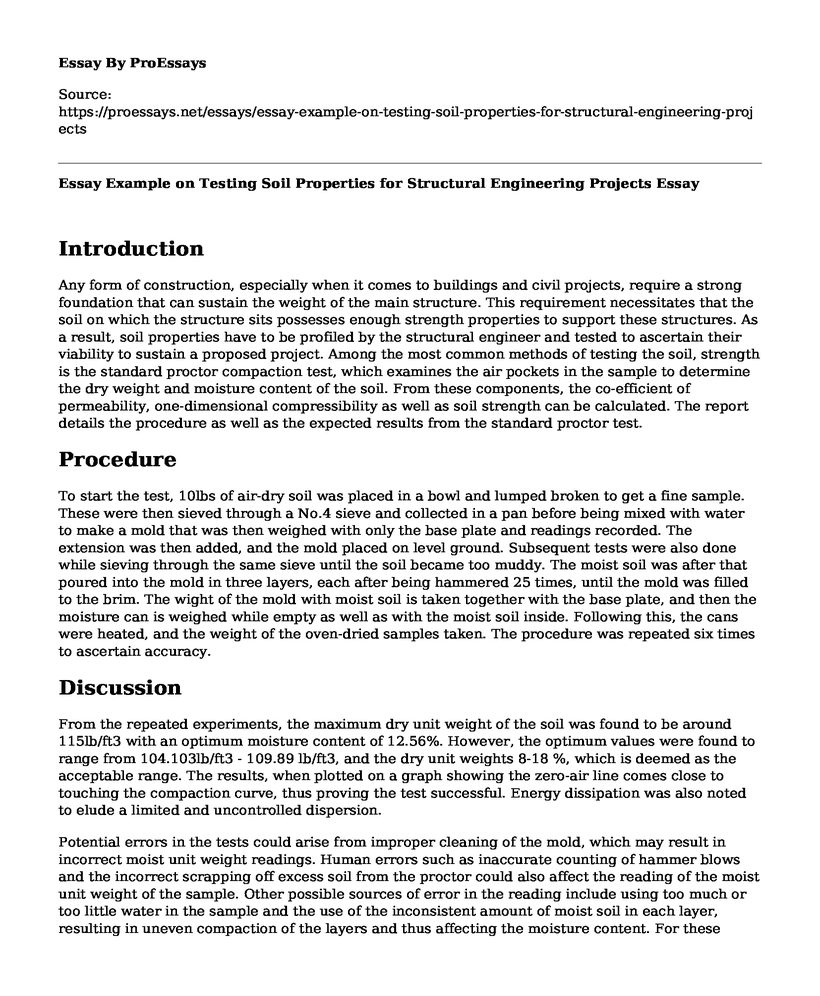Introduction
Any form of construction, especially when it comes to buildings and civil projects, require a strong foundation that can sustain the weight of the main structure. This requirement necessitates that the soil on which the structure sits possesses enough strength properties to support these structures. As a result, soil properties have to be profiled by the structural engineer and tested to ascertain their viability to sustain a proposed project. Among the most common methods of testing the soil, strength is the standard proctor compaction test, which examines the air pockets in the sample to determine the dry weight and moisture content of the soil. From these components, the co-efficient of permeability, one-dimensional compressibility as well as soil strength can be calculated. The report details the procedure as well as the expected results from the standard proctor test.
Procedure
To start the test, 10lbs of air-dry soil was placed in a bowl and lumped broken to get a fine sample. These were then sieved through a No.4 sieve and collected in a pan before being mixed with water to make a mold that was then weighed with only the base plate and readings recorded. The extension was then added, and the mold placed on level ground. Subsequent tests were also done while sieving through the same sieve until the soil became too muddy. The moist soil was after that poured into the mold in three layers, each after being hammered 25 times, until the mold was filled to the brim. The wight of the mold with moist soil is taken together with the base plate, and then the moisture can is weighed while empty as well as with the moist soil inside. Following this, the cans were heated, and the weight of the oven-dried samples taken. The procedure was repeated six times to ascertain accuracy.
Discussion
From the repeated experiments, the maximum dry unit weight of the soil was found to be around 115lb/ft3 with an optimum moisture content of 12.56%. However, the optimum values were found to range from 104.103lb/ft3 - 109.89 lb/ft3, and the dry unit weights 8-18 %, which is deemed as the acceptable range. The results, when plotted on a graph showing the zero-air line comes close to touching the compaction curve, thus proving the test successful. Energy dissipation was also noted to elude a limited and uncontrolled dispersion.
Potential errors in the tests could arise from improper cleaning of the mold, which may result in incorrect moist unit weight readings. Human errors such as inaccurate counting of hammer blows and the incorrect scrapping off excess soil from the proctor could also affect the reading of the moist unit weight of the sample. Other possible sources of error in the reading include using too much or too little water in the sample and the use of the inconsistent amount of moist soil in each layer, resulting in uneven compaction of the layers and thus affecting the moisture content. For these tests, the researcher raised the moisture content by 2-5%, and the measurements were taken after 72 hours instead of the 24 recommended in the ASTM standards.
Conclusion
From the lab test, the dry unit weight of the soil was found to be between 104.103 and 109.89 lb/ft3, which can be deemed as an acceptable range for the client to build on. These ranges demonstrate the factor of safety which the contractor can build on based on the conditions of the soil at the site. It would, however, be recommendable that the client uses the flocculated side of the curve as the soil in that area would bear more strength.
Cite this page
Essay Example on Testing Soil Properties for Structural Engineering Projects. (2023, Feb 27). Retrieved from https://proessays.net/essays/essay-example-on-testing-soil-properties-for-structural-engineering-projects
If you are the original author of this essay and no longer wish to have it published on the ProEssays website, please click below to request its removal:
- Paper Example on Quality Function Development
- Inside of a Car - Essay Sample
- Size Effect in Concrete Beams Essay Example
- Human Factors in Aviation Maintenance Essay Example
- Research Paper on Construction Falls
- Engineering Research for Cost-Effectiveness & Value Addition - Essay Sample
- Paper Sample: Fresh Graduate Pursues Master's in Electrical Engineering at KFUPM







